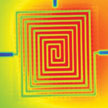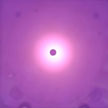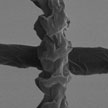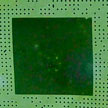Showing Spotlights 1081 - 1088 of 2780 in category All (newest first):
 Advanced health monitoring systems and healthcare devices will become an integral part of the Internet of Things. As a harbinger of things to come, nanotechnology researchers have now demonstrated a smart thermal patch which can be used for thermotherapy for pain management in a user interactive way. To fabricate the device, the researchers used CMOS technology to devise a silicon based smart thermal patch which is flexible and stretchable.
Advanced health monitoring systems and healthcare devices will become an integral part of the Internet of Things. As a harbinger of things to come, nanotechnology researchers have now demonstrated a smart thermal patch which can be used for thermotherapy for pain management in a user interactive way. To fabricate the device, the researchers used CMOS technology to devise a silicon based smart thermal patch which is flexible and stretchable.
Dec 9th, 2014
 Drawing attention to the possible implications of extreme weather does not answer the question what we can really do about the risks of climate change, and who will drive fresh solutions. Science - including nanotechnology - is an important part of the answer, and we need human ingenuity to step forward. To accelerate the process and help to push the boundaries of usable energy solutions, the Exergeia Project backs potentially groundbreaking inventions and innovations in all fields of alternative energy.
Drawing attention to the possible implications of extreme weather does not answer the question what we can really do about the risks of climate change, and who will drive fresh solutions. Science - including nanotechnology - is an important part of the answer, and we need human ingenuity to step forward. To accelerate the process and help to push the boundaries of usable energy solutions, the Exergeia Project backs potentially groundbreaking inventions and innovations in all fields of alternative energy.
Dec 5th, 2014
 Graphene's properties appear to have almost limitless application potential, ranging from composite materials for the aerospace industry, next-generation batteries and supercapacitors, flexible displays and optical electronics and biosensors for applications in healthcare and medical devices. So why hasn't graphene, with the potential to vastly outperform the majority of currently available materials, been integrated into everything from wristwatches to ocean liners?
Graphene's properties appear to have almost limitless application potential, ranging from composite materials for the aerospace industry, next-generation batteries and supercapacitors, flexible displays and optical electronics and biosensors for applications in healthcare and medical devices. So why hasn't graphene, with the potential to vastly outperform the majority of currently available materials, been integrated into everything from wristwatches to ocean liners?
Dec 4th, 2014
 A majority of the members of the Environmental, Public Health and Food Safety (EHS) committee of the European Parliament approved several amendments to the draft regulation on novel foods, including one imposing a moratorium on novel foods containing nanomaterials. The EHS committee's amendments to the Commission's proposal show that the European Parliament and the European Commission clearly have two different approaches towards the regulation of nanotechnologies.
A majority of the members of the Environmental, Public Health and Food Safety (EHS) committee of the European Parliament approved several amendments to the draft regulation on novel foods, including one imposing a moratorium on novel foods containing nanomaterials. The EHS committee's amendments to the Commission's proposal show that the European Parliament and the European Commission clearly have two different approaches towards the regulation of nanotechnologies.
Dec 3rd, 2014
 The use of copper as an alternative electrode material to silver would reduce the cost of conductive inks. Nevertheless, copper nanowire conductors face a serious bottleneck for future practical use in flexible and stretchable optoelectronics: although they are nearly as conductive as silver, this conductivity is not stable. Researchers have now demonstrated conductive copper nanowire elastomer composites with ultrahigh performance stability against oxidation, bending, stretching, and twisting. This material offers a promising alternative as electrodes for flexible and stretchable optoelectronics.
The use of copper as an alternative electrode material to silver would reduce the cost of conductive inks. Nevertheless, copper nanowire conductors face a serious bottleneck for future practical use in flexible and stretchable optoelectronics: although they are nearly as conductive as silver, this conductivity is not stable. Researchers have now demonstrated conductive copper nanowire elastomer composites with ultrahigh performance stability against oxidation, bending, stretching, and twisting. This material offers a promising alternative as electrodes for flexible and stretchable optoelectronics.
Dec 2nd, 2014
 The successful implementation of graphene-based devices invariably requires the precise patterning of graphene sheets at both the micrometer and nanometer scale. Finding the ideal technique to achieve the desired graphene patterning remains a major challenge. Researchers have now demonstrated 3D printed nanostructures composed entirely of graphene using a new 3D printing technique. The method exploits a size-controllable liquid meniscus to fabricate 3D reduced graphene oxide nanowires.
The successful implementation of graphene-based devices invariably requires the precise patterning of graphene sheets at both the micrometer and nanometer scale. Finding the ideal technique to achieve the desired graphene patterning remains a major challenge. Researchers have now demonstrated 3D printed nanostructures composed entirely of graphene using a new 3D printing technique. The method exploits a size-controllable liquid meniscus to fabricate 3D reduced graphene oxide nanowires.
Nov 27th, 2014
 The space industry has a strong requirement to develop flexible electrostatic discharge protection layers for the exterior cover of satellites in order to protect the electronics of the spacecraft. A new study explores carbon nanotube-polyimide composite materials as a flexible alternative for the currently used indium tin oxide (ITO) coating, which is brittle and suffers from severe degradation of the electrical conductance due to fracture of the coating upon bending.
The space industry has a strong requirement to develop flexible electrostatic discharge protection layers for the exterior cover of satellites in order to protect the electronics of the spacecraft. A new study explores carbon nanotube-polyimide composite materials as a flexible alternative for the currently used indium tin oxide (ITO) coating, which is brittle and suffers from severe degradation of the electrical conductance due to fracture of the coating upon bending.
Nov 26th, 2014
 White-light-emitting diodes have many advantages over forms of lighting - incandescent, fluorescent and halogen - and this solid-state lighting technique is bound to make major inroads into the commercial and household markets. Researchers have now designed precursors and chemical processes to synthesize intercrossed carbon nanomaterials with relatively pure hydroxy surface states for the first time, which enable them to overcome the aggregation-induced quenching (AIQ) effect, and to emit stable yellow-orange luminescence in both colloidal and solid states.
White-light-emitting diodes have many advantages over forms of lighting - incandescent, fluorescent and halogen - and this solid-state lighting technique is bound to make major inroads into the commercial and household markets. Researchers have now designed precursors and chemical processes to synthesize intercrossed carbon nanomaterials with relatively pure hydroxy surface states for the first time, which enable them to overcome the aggregation-induced quenching (AIQ) effect, and to emit stable yellow-orange luminescence in both colloidal and solid states.
Nov 25th, 2014
 Advanced health monitoring systems and healthcare devices will become an integral part of the Internet of Things. As a harbinger of things to come, nanotechnology researchers have now demonstrated a smart thermal patch which can be used for thermotherapy for pain management in a user interactive way. To fabricate the device, the researchers used CMOS technology to devise a silicon based smart thermal patch which is flexible and stretchable.
Advanced health monitoring systems and healthcare devices will become an integral part of the Internet of Things. As a harbinger of things to come, nanotechnology researchers have now demonstrated a smart thermal patch which can be used for thermotherapy for pain management in a user interactive way. To fabricate the device, the researchers used CMOS technology to devise a silicon based smart thermal patch which is flexible and stretchable.
 Subscribe to our Nanotechnology Spotlight feed
Subscribe to our Nanotechnology Spotlight feed





